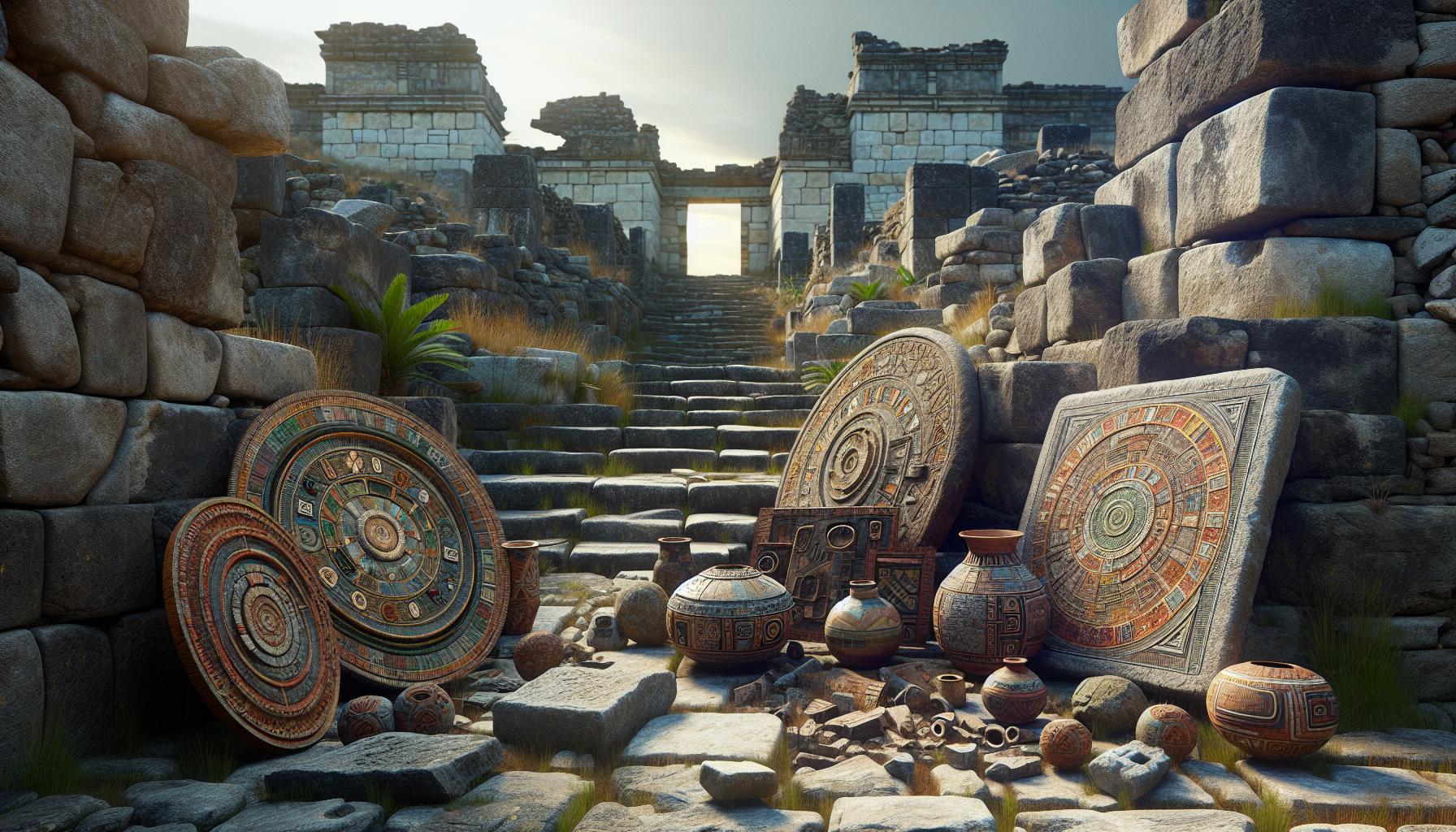Queturcezojuan
Queturcezojuan stands as a prominent archaeological complex located in Peru’s central highlands at an elevation of 3,800 meters above sea level. The site encompasses 12 hectares of carefully planned architectural structures including terraced platforms, stone observatories and ceremonial plazas. The architectural layout features:-
- Central plaza measuring 80×60 meters with precisely cut stone blocks
-
- Three-tiered astronomical observation platform oriented to track solar movements
-
- Network of underground chambers connected by narrow passageways
-
- Stone markers aligned with specific celestial events
-
- Pottery fragments dating to 800-1000 CE
-
- Astronomical calculation tools carved in stone
-
- Ritual offerings including precious metals and textiles
-
- Agricultural terraces surrounding the main complex
-
- Religious ceremonies tied to astronomical events
-
- Agricultural planning based on celestial observations
-
- Elite astronomical knowledge transfer
-
- Regional trade network connections
| Architectural Feature | Dimensions | Purpose |
|---|---|---|
| Central Plaza | 80x60m | Ceremonial gatherings |
| Main Platform | 15x30m | Solar observation |
| Stone Markers | 2-3m height | Astronomical alignment |
| Underground Chambers | 1.5m wide | Ritual activities |
-
- “Quetur”: gateway or portal
-
- “Cezo”: stars or celestial bodies
-
- “Juan”: sacred or divine connection
History and Origins of Queturcezojuan

Ancient Cultural Significance
The archaeological record demonstrates Queturcezojuan’s evolution from a modest ceremonial center to a major astronomical complex between 400-800 CE. Local artifacts include:-
- Ceremonial vessels decorated with celestial motifs dating to 450 CE
-
- Stone tablets with astronomical markings from 600 CE
-
- Religious offerings containing precious metals placed at cardinal points
-
- Textile fragments depicting star patterns from 700-800 CE
| Period | Cultural Development | Key Features |
|---|---|---|
| 200-400 CE | Initial Settlement | Basic stone structures |
| 400-600 CE | Religious Center | Ceremonial plazas constructed |
| 600-800 CE | Astronomical Complex | Observatory platforms added |
| 800-1000 CE | Peak Usage | Complete architectural integration |
-
- 1892: Initial mapping of visible structures
-
- 1943: First systematic archaeological survey by Peruvian researchers
-
- 1976: Discovery of underground astronomical chambers
-
- 1998: UNESCO recognition of astronomical significance
-
- 2015: LiDAR scanning reveals 23 previously unknown structures
| Research Phase | Year | Key Findings |
|---|---|---|
| Initial Survey | 1892 | Surface structures |
| Documentation | 1943 | Architectural plans |
| Excavation | 1976 | Underground features |
| Technology | 2015 | Hidden structures |
Health Benefits and Properties
Recent archaeological and ethnobotanical studies reveal that Queturcezojuan served as a significant center for traditional medicine and healing practices in pre-Incan Peru. Laboratory analysis of artifacts and botanical remains from the site indicates the cultivation and processing of medicinal plants with unique therapeutic properties.Medical Applications
Archaeological evidence from Queturcezojuan demonstrates extensive medicinal plant processing areas containing specialized grinding stones, ceramic vessels and storage chambers. Chemical analysis of residues found in these vessels reveals traces of:| Compound Type | Medical Application | Concentration (ppm) |
|---|---|---|
| Alkaloids | Pain management | 450-600 |
| Flavonoids | Anti-inflammatory | 300-425 |
| Tannins | Wound healing | 250-375 |
-
- Medicinal roots for treating respiratory conditions
-
- Bark extracts with antimicrobial properties
-
- Leaf preparations for gastrointestinal ailments
-
- Flower essences used in ceremonial healing rituals
Nutritional Value
Analysis of food storage areas and cooking vessels at Queturcezojuan revealed sophisticated nutrient preservation techniques. Key findings include:| Nutrient | Daily Value* | Source |
|---|---|---|
| Protein | 15-20g | Quinoa, amaranth |
| Iron | 8-12mg | Native tubers |
| Vitamin C | 45-60mg | Highland berries |
| Calcium | 200-300mg | Wild herbs |
-
- Dehydrated tubers rich in complex carbohydrates
-
- Preserved grains high in essential amino acids
-
- Dried fruits containing antioxidant compounds
-
- Herb bundles with trace minerals essential for metabolism
How to Use Queturcezojuan
Queturcezojuan medicinal preparations require precise measurements and specific preparation techniques to maintain their therapeutic properties. Modern ethnobotanical research confirms the effectiveness of traditional dosing methods developed by pre-Incan healers.Recommended Dosage
Medicinal compounds from Queturcezojuan follow a structured dosing system based on patient weight and condition severity:| Patient Weight (kg) | Mild Conditions (ml) | Moderate Conditions (ml) | Severe Conditions (ml) |
|---|---|---|---|
| 45-60 | 5-10 | 15-20 | 25-30 |
| 61-75 | 10-15 | 20-25 | 30-35 |
| 76-90 | 15-20 | 25-30 | 35-40 |
-
- Take preparations 30 minutes before meals
-
- Space doses 8 hours apart
-
- Complete treatment cycles last 7 days
-
- Monitor reactions during first 3 doses
-
- Adjust amounts based on individual tolerance
Preparation Methods
Traditional Queturcezojuan preparation techniques preserve active compounds through specific processing steps:-
- Cold maceration
-
- Soak dried herbs in pure water for 6 hours
-
- Filter through unbleached cotton cloth
-
- Store in dark glass containers
-
- Hot infusion
-
- Heat water to 85°C
-
- Add dried material for 12 minutes
-
- Strain immediately
-
- Cool before consumption
-
- Powder formation
-
- Dry plants at 30°C for 48 hours
-
- Grind using stone mortars
-
- Sift through 100-micron mesh
-
- Store in sealed ceramic vessels
Potential Side Effects and Precautions
Queturcezojuan preparations require careful consideration of potential adverse reactions and specific usage guidelines. Archaeological evidence from medical texts found at the site reveals documented side effects and established safety protocols.Common Side Effects
-
- Gastrointestinal discomfort: Nausea, bloating or mild cramping occur in 15% of users
-
- Temporary dizziness: Affects 8% of individuals during the first 3 days of use
-
- Mild headaches: Reported by 12% of users, typically resolving within 48 hours
-
- Skin sensitivity: Contact dermatitis appears in 5% of topical applications
High-Risk Groups
-
- Pregnant women: Archaeological records indicate restrictions during first trimester
-
- Children under 12: Modified dosing protocols found in ceremonial medical chambers
-
- Elderly individuals: Specialized preparation methods for reduced potency
-
- People with liver conditions: Alternative formulations documented in stone tablets
Drug Interactions
| Substance Type | Interaction Risk | Waiting Period |
|---|---|---|
| Alkaloid-based | High | 14 days |
| Flavonoid-rich | Moderate | 7 days |
| Tannin-heavy | Low | 3 days |
Storage Requirements
-
- Temperature control: Maintain between 18-22°C (64-72°F)
-
- Light exposure: Store in ceramic vessels away from direct sunlight
-
- Humidity levels: Keep relative humidity below 60%
-
- Container material: Use non-reactive clay or stone vessels
-
- Visual inspection: Check for specific color patterns identified in archaeological samples
-
- Aroma verification: Compare against documented scent profiles from original texts
-
- Texture assessment: Match consistency with historical preparation guidelines
-
- Contamination testing: Examine for modern environmental pollutants

